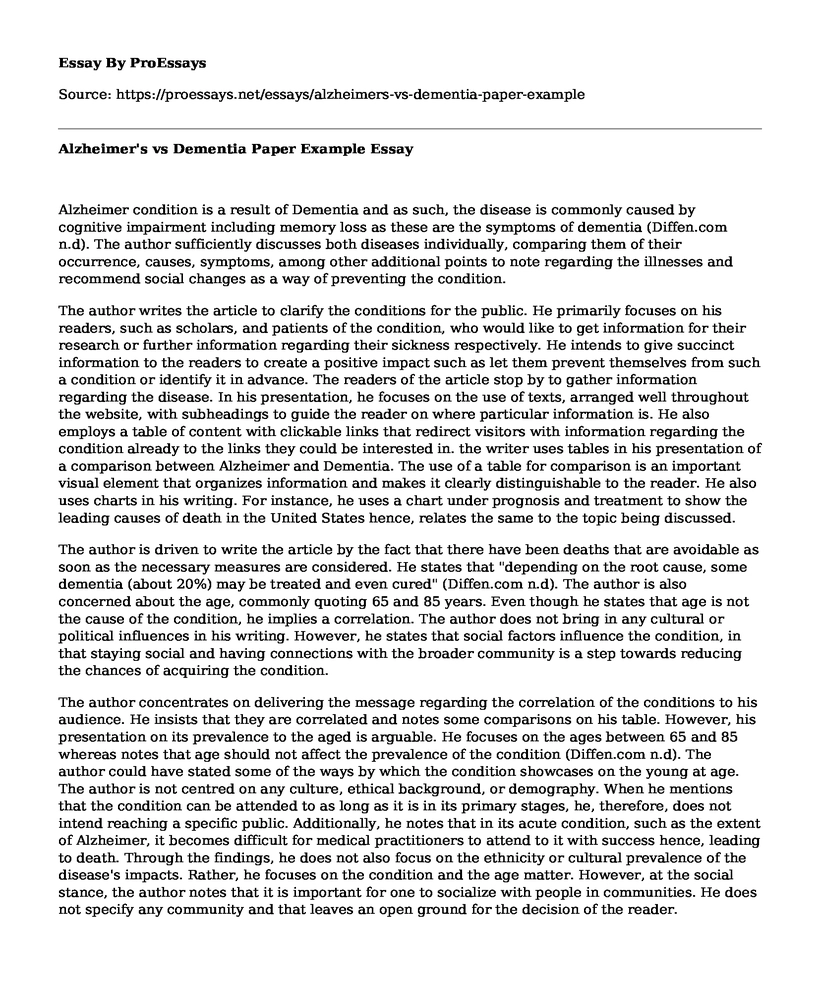Alzheimer condition is a result of Dementia and as such, the disease is commonly caused by cognitive impairment including memory loss as these are the symptoms of dementia (Diffen.com n.d). The author sufficiently discusses both diseases individually, comparing them of their occurrence, causes, symptoms, among other additional points to note regarding the illnesses and recommend social changes as a way of preventing the condition.
The author writes the article to clarify the conditions for the public. He primarily focuses on his readers, such as scholars, and patients of the condition, who would like to get information for their research or further information regarding their sickness respectively. He intends to give succinct information to the readers to create a positive impact such as let them prevent themselves from such a condition or identify it in advance. The readers of the article stop by to gather information regarding the disease. In his presentation, he focuses on the use of texts, arranged well throughout the website, with subheadings to guide the reader on where particular information is. He also employs a table of content with clickable links that redirect visitors with information regarding the condition already to the links they could be interested in. the writer uses tables in his presentation of a comparison between Alzheimer and Dementia. The use of a table for comparison is an important visual element that organizes information and makes it clearly distinguishable to the reader. He also uses charts in his writing. For instance, he uses a chart under prognosis and treatment to show the leading causes of death in the United States hence, relates the same to the topic being discussed.
The author is driven to write the article by the fact that there have been deaths that are avoidable as soon as the necessary measures are considered. He states that "depending on the root cause, some dementia (about 20%) may be treated and even cured" (Diffen.com n.d). The author is also concerned about the age, commonly quoting 65 and 85 years. Even though he states that age is not the cause of the condition, he implies a correlation. The author does not bring in any cultural or political influences in his writing. However, he states that social factors influence the condition, in that staying social and having connections with the broader community is a step towards reducing the chances of acquiring the condition.
The author concentrates on delivering the message regarding the correlation of the conditions to his audience. He insists that they are correlated and notes some comparisons on his table. However, his presentation on its prevalence to the aged is arguable. He focuses on the ages between 65 and 85 whereas notes that age should not affect the prevalence of the condition (Diffen.com n.d). The author could have stated some of the ways by which the condition showcases on the young at age. The author is not centred on any culture, ethical background, or demography. When he mentions that the condition can be attended to as long as it is in its primary stages, he, therefore, does not intend reaching a specific public. Additionally, he notes that in its acute condition, such as the extent of Alzheimer, it becomes difficult for medical practitioners to attend to it with success hence, leading to death. Through the findings, he does not also focus on the ethnicity or cultural prevalence of the disease's impacts. Rather, he focuses on the condition and the age matter. However, at the social stance, the author notes that it is important for one to socialize with people in communities. He does not specify any community and that leaves an open ground for the decision of the reader.
The author focuses on a medical practitioner's ethics. For instance, he does not integrate cultural differences in his text. This instance shows how the author keeps the lane of the medical practitioners. The author provides various examples as pieces of evidence towards the disease. He notes some figures including the ages and prevalence of the disease. He, for instance, quotes some researches performed by scientists from the UK who conducted a research on the Alzheimer disease (Diffen.com n.d). Through these supports, the author provides evidence regarding his data and figures. The fact that credible sources have been used throughout the article is a motivation to vouch for the credibility of the statements of the author and the conclusions drawn.
As soon as the reader notes his arguments regarding the condition, they can be positively influenced in that they can avoid the condition, or notice it early and seek medical advice. The reasoning of the audience can change as soon as they learn about the condition differently. They can employ the learning to the field for the good of their communities.
Works cited
Diffen.com. "Alzheimer's vs. Dementia." Diffen, Diffen, LLC, www.diffen.com/difference/Alzheimer's_vs_Dementia.
Cite this page
Alzheimer's vs Dementia Paper Example. (2022, Sep 11). Retrieved from https://proessays.net/essays/alzheimers-vs-dementia-paper-example
If you are the original author of this essay and no longer wish to have it published on the ProEssays website, please click below to request its removal:
- Paper Example on Patient Information Management Program
- Miss Jose's Health Condition Paper Example
- A Comprehensive Summary of My Dietary Intake: Tracking Progress Paper Example
- Essay Example on Kindred Hospital: Extended Medical Care & Specialty Services in North Dallas
- Essay Sample on Social Media: A Preferred Practice for Modern Health Care
- Understanding Microcytic Anemia: Causes, Tests & Treatments - Essay Sample
- Prevalence of Type 2 Diabetes in Disadvantaged Populations in Chicago, USA - Essay Sample







